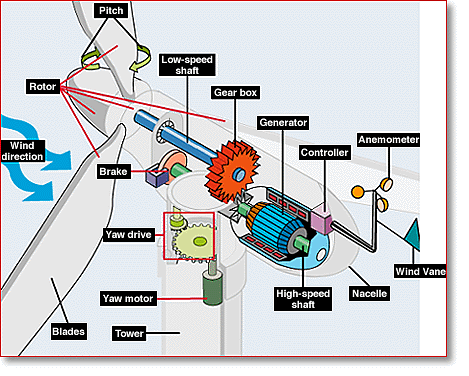And I’m not talking about the movie of the same title… Do you know how much a cubic meter of dry air weighs at sea level?
About 1kg (1.0007 kg to be exact.) Air also has pressure, at sea level, about 10,194 kg/square meter (14.5 lbs/square inch.) Air also moves, you might have noticed this phenomena called wind. As the Sun heats the atmosphere air will naturally flow (convection) moving from high pressure areas to low pressure areas – it’s effectively a way for the atmosphere to move heat around.
So we’ve got mass and we’ve got movement which means that there must be a way to harness this excess energy flowing around the planet. For many thousands of years humans have used sails to capture the wind and for hundreds of years, sails anchored in place attached to a shaft converting wind energy to mechanical energy. This energy was used in the past to pump water, saw wood, grind things, etc. Today, high efficiency wind turbines are available and being installed for the purpose of converting wind energy into electricity.
Utility scale wind turbines

Each wind turbine has a shaft connected to a gearbox that drives an electrical generator. The turbines also have brakes, yaw and pitch controls, weather stations, and power transmission capability built into them (see diagram below.) Each turbine in a wind farm transmits its power to a shared substation where the electricity is stepped up to the right voltage to enter a supply line for the electricity grid.

The electric production capacity harvested from wind energy has grown from 2.8 gigawatt hours (GWh) in 1992 to 18.8 GWh in 2006 (trailing twelve month calculation.) Wind farms are now sprouting up in many different states across the US with Texas now leading wind production closely followed by California.
Major advantages to wind generated electricity start with fuel cost, $0. Wind farms are also very low impact on the environment in terms of emitted pollution into the atmosphere, ground, and water. In addition, wind farms literally provide another crop for farmers as the actual land usage tends to be small (less than 200 sq meters) for each turbine allowing agriculture to continue even as wind is harvested. Wind farms are also relatively easy to construct and put into service taking an average of 18 months to complete.
The major disadvantages to wind power are predictability of supply, one cannot guarantee that wind will blow when demand for power exists. Also, aesthetics, many people do not like to see ridges peppered with large steel towers with rotating props. And finally, avian impacts. In some wind installations, the death rate for birds, particularly raptors is elevated due to collisions with the props and towers. Each of these issues has solutions and with each new installation, the objections decrease.
Even taking into account the disadvantages, wind still is a vital part of the renewable energy portfolio and continues to grow at a fast pace.
Ohio State’s 2006 record: 7-0 Next up: Indiana 10/21
Tune: Where it’s at by Beck
Technorati Tags: Energy | Wind | Turbine | Mike Harding Blog
« Maybe change is afoot…
» Poll mania
Energy
A Mighty Wind
10.18.06 | 9 Comments
9 Comments
« Maybe change is afoot…
» Poll mania










Would it be possible to use some pictures of a wind turbine on your websit as i need it for my ICT work. Noone will se the picture apart from me and my classmates. Would this be possible
Hi im doin and website for my Schools creativity week and i just wanna know if i can get prermission to use your wind turbine pic
Feel free to download and use the picture.
Hi,
Wind turbine picture needed for a project which will not be published, only assessed internally.
Could I use your excellent picture?
Rick
hi
i’m doing a project on wind farms for my school…would it be possible fro me to use your picture of the wind turbine?
thanks
Jennifar
Jennifar et al, it is OK to use the photo. Please feel free to do so.
[…] – A Mighty Wind – An oldie, but goodie that describes in detail how wind power is harvested. Authored in 2006, it […]
Super web site / hope to come back soon..
Dear sir
My name is behnam khalilian.I’m manager of F.S.E company. We
are the group of inventors of iran , that we investigate
about propeller of wind turbines.
We have succeed for designing and making of primary sample
of new propeller for using in wind turbines.
That it moves with special method and it is able to absorb
and prouduct of double energy from wind with regard to
current usual propellers. In addition to product of match
energy, this kind of propeller also has more benefits.
So, if you have a tendency toward using this kind of
propeller we declare our preparedness for necessary
cooprations.
Our E-mail: fse_co_ ir@yahoo.com or
Behnamkhalilian@yahoo.com
It is hoped that the human kind obtain all of its necessity
energy from clean and pure energies.
With best regards,
Behnam khalilian